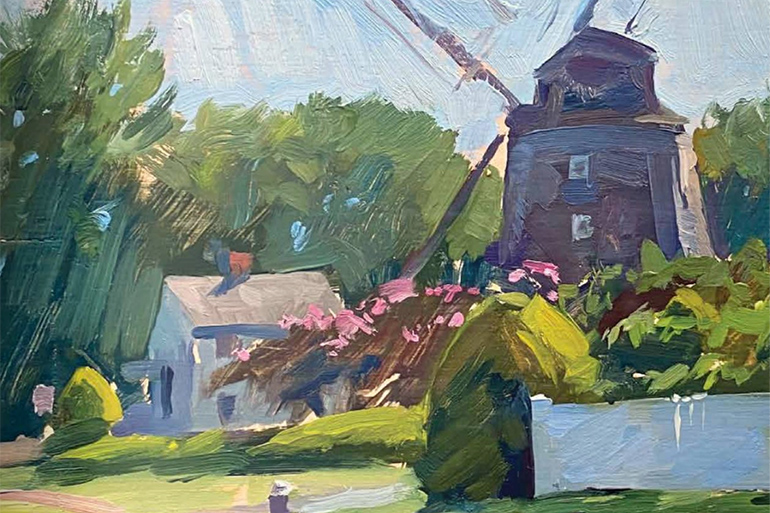Dan's Papers Cover Artist Marc Dalessio Paints a Local Windmill

This week’s April 17, 2020 Dan’s Papers cover artist Marc Dalessio talks about his formal training, innovative technique and how traveling the world as a child has shaped his artistic eye.

What was the inspiration for this piece?
It was a beautiful morning in May and I was staying in East Hampton. I was out scouting for views and I thought the composition, colors, and shapes worked really well in this subject. Obviously the windmill was the focus, but I also loved the blue shadows in the white fence and the variety of greens in the foliage. Also, while there is a lot of precedent for such a view in art history, I also lived in the Netherlands for a bit and painted a number of windmills there, so there was a personal nostalgia to the piece.
Talk about your plein air style.
I first studied landscape painting at UC Santa Cruz, where the early Californian Impressionists were the model we all aspired to. Later, I moved to Florence, Italy where I trained as a portrait painter in a rigorously academic institution with a curriculum based on cast drawing. These two influences paralleled the Nietzschean idea of the dichotomy of Apollonian and Dionysian elements in art that we were taught in Italy. The premise that great art is the result of the merging of strong emotion with dexterous skill, honed through years of monotonous and repetitive study.
My work is also based on the idea, adapted from the Florentine Neoplatonist Giovanni Pico della Mirandola, that the artist is nature revering itself. As such, I’ve attempted to avoid developing any personal mannerisms in my paintings, and to allow nature to depict itself as much as is humanly possible. So my style, if I have one, has come about by trying to avoid any style.
Tell us about your artistic process.
I paint using a method called sight-size. It means that I have the canvas and the view in a position where I see them both at the same size and can quickly copy what I see. It’s originally a technique for portraiture, but I find it works well with plein air painting as I can work fast and keep up with the changing effects. It fits well with my philosophy on art as well. I use a limited palette of colors, and I have spent years refining a very lightweight set-up for working that allows me to walk a lot a great deal with my gear. I try to find the exact view that I want to paint, and I try not to change the natural world in my paintings. I would rather walk a bit further to get the composition that I want, rather than moving things around.
You traveled often as a child. How did growing up seeing the world inform your art?
I lived in the Fiji Islands for a number of years as a child and I really fell in love with the natural world there. That feeling of awe and wonder has stayed with me ever since and transformed over the years into a constant state of inspiration as an artist. Today I’m able to step outside and find subjects for my paintings everywhere. I also feel very relaxed about travel and moving. I’ve lived in three countries in the last ten years, and I spend months traveling in the landscape season without any problems.
If you weren’t an artist what would you be doing?
I originally studied biology in college, because I felt that studying the natural world would be the best way to show my reverence. I would probably be doing field biology if I couldn’t be a painter.
See more of Marc Dalessio’s work at marcdalessio.com and at grenninggallery.com.




